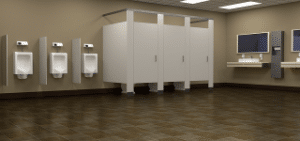Toilet Flapper Troubleshooting in Facility Bathrooms

When your facility bathrooms aren’t working properly, you can quickly end up with complaints and messes disrupting your workday. Problems like these often start with minor defects in your toilet components, such as the toilet flapper.
The toilet flapper is a black rubber plug at the bottom of the toilet tank, on the end of the overflow tube. It’s connected by a chain to the trip lever, which is controlled by the toilet flush handle. When you flush, the trip lever raises the toilet flapper to let water flow into the toilet bowl. It then drops down and creates a seal to stop the flow of water.
When the Toilet Won’t Stop Running
If you notice water continues to flow into the bowl more than a few minutes after you flush, a damaged toilet flapper is the likely culprit. Over time, the rubber flapper stiffens, deforms or deteriorates, which prevents it from creating a tight seal. As a result, water from the tank leaks into the bowl long after the flush ends.
You then have a toilet that runs incessantly. You might also notice “phantom flushes” in which the toilet flushes by itself and the bowl refills with water.
To test the flapper for leakage, add a little food coloring to the water in the tank. Wait 10 minutes and check the water in the bowl. If it’s colored, your flapper isn’t sealing completely.
A toilet that runs or flushes itself wastes water. Worse yet, your employees and guests may try to jiggle the handle or knock the tank to stop the running. Enough people doing this can eventually damage the toilet. A deteriorated or deformed flapper can’t be repaired, so you’ll need to replace it.
To install a new flapper, start by shutting off the water supply to the toilet and flushing the toilet to drain the tank. Take out the flapper by unhooking the chain from the trip lever then unhooking each ear, or side, of the flapper from the flush valve.
For most toilets, you’ll need to cut the back ring off the new flapper, place the flapper onto the flush valve and hook each ear into place. For others, you’ll use the ring to slide the flapper into place. Finally, hook the chain onto the trip lever. Leave enough slack so the flapper can settle firmly against the valve, but not so much the chain could tangle.
When the Flush isn’t Sufficient
If you find the flush ends too soon and too little water is left in toilet bowl, you may have an incorrectly adjusted flapper chain or a waterlogged flapper. These issues cause the flapper to drop down too quickly, cutting off the water flowing into the tank.
To check for this toilet problem, remove the tank cover and watch the flapper as you flush the toilet. The flapper should stay raised until around 80 percent of the tank’s water has drained into the bowl. If it drops sooner, the chain may be too short. Remove the chain and loosen it by two links. If adjusting the chain doesn’t help, you’ll need to install a new flapper.
A weak flush is another problem caused by an incorrectly adjusted flapper. In this case, the toilet doesn’t flush completely and you have to hold the handle down to get a full flush. To solve this issue, first make sure the chain is attached to the flapper and, if it isn’t, reattach it. If the chain is attached, but looks loose, remove it and tightened it by two links.
Our goal is to help educate our customers about Plumbing, HVACR, Fire Protection, and Alarm Systems in Mechanical, Commercial, and Residential settings. For more information about maintaining toilet flapper and other plumbing components, and to view projects we’ve worked on, visit our website!
Photo Credit: Pixabay







